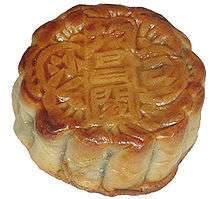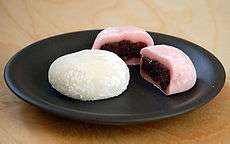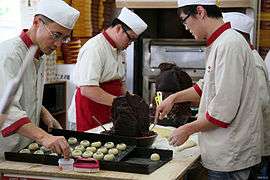Red bean paste
|
| |
| Alternative names | Adzuki bean paste |
|---|---|
| Type | Sweet paste |
| Place of origin | China |
| Main ingredients | Adzuki beans, sugar or honey |
|
| |
Red bean paste (Chinese: 红豆沙) or adzuki bean paste is a dark red, sweet bean paste. It is used in Chinese cuisine, Japanese confectionery, and Korean cuisine. It is prepared by boiling and mashing adzuki beans and then sweetening the paste with sugar or honey. The husk of the beans may be removed by sieving before sweetening, which leads to a smoother and more homogeneous paste.
Types
Red bean paste is graded according to its consistency.
In Chinese cuisine, the most common types are:[1]
- Mashed: Adzuki beans are boiled with sugar and mashed. The paste is smooth with bits of broken beans and bean husk. Depending on the intended texture, the beans can be vigorously or lightly mashed. Some unmashed beans can also be added back into the bean paste for additional texture. This is the most common and popular type of red bean paste eaten in Chinese confections. Can also be eaten on its own or in sweet soups.
- Smooth: Adzuki beans are boiled without sugar, mashed, and diluted into a slurry. The slurry is then strained through a sieve to remove the husk, filtered, and squeezed dry using cheesecloth. Although the dry paste can be directly sweetened and used, oil, either vegetable oil or lard, is usually used to cook the dry paste and improve its texture and mouth feel. Smooth bean paste is mainly found as fillings for Chinese pastries.
In Japanese cuisine, the most common types are:
- Tsubuan (粒餡), whole red beans boiled with sugar but otherwise untreated
- Tsubushian (潰し餡), where the beans are mashed after boiling
- Koshian (漉し餡), which has been passed through a sieve to remove bean skins; the most common type
- Sarashian (晒し餡), which has been dried and reconstituted with water
Etymology
| Red bean paste | |||||||||||||||
| Chinese name | |||||||||||||||
|---|---|---|---|---|---|---|---|---|---|---|---|---|---|---|---|
| Simplified Chinese | 红豆沙 | ||||||||||||||
| Traditional Chinese | 紅豆沙 | ||||||||||||||
| Hanyu Pinyin | hóngdòushā | ||||||||||||||
| |||||||||||||||
| Korean name | |||||||||||||||
| Hangul | 팥소 / 적두함 | ||||||||||||||
| Hanja | 赤豆餡 | ||||||||||||||
| |||||||||||||||
| Japanese name | |||||||||||||||
| Kanji | 餡 / 小豆餡 | ||||||||||||||
| |||||||||||||||
In Japanese, a number of names are used to refer to red bean paste; these include an (餡), anko (餡子), and ogura (小倉). Strictly speaking, the term an can refer to almost any sweet, edible, mashed paste, although without qualifiers red beans are assumed. Common alternatives include shiroan (白餡), made from Japanese white beans (白いんげん豆 shiro-ingenmame), and kurian (栗餡), made from chestnuts.
Similarly, the Chinese term dòushā (豆沙), applies to red bean paste when used without qualifiers, although hóngdòushā (紅豆沙) explicitly means "red bean paste."
Uses



Chinese
Red bean paste is used in many Chinese foods, such as:
- Red bean soup (紅豆湯/紅豆沙; pinyin: hóng dòu tāng / hóng dòu shā): Red bean paste with more water added to form a tong sui, or thick, sweet soup. It is often cooked and eaten with tangyuan and lotus seeds. This is almost always a dessert.
- Tangyuan (湯圓, pinyin: tāng yúan): Glutinous rice balls filled with sweet fillings such as red bean paste and boiled in plain or sweetened water
- Zongzi (粽子; pinyin: zòng zi): Glutinous rice and red bean paste wrapped with bamboo leaves and steamed or boiled. The glutinous rice used to make zongzi is usually specially prepared and appears yellow.
- Mooncakes (月餅; yùe bĭng): A baked pastry consisting of thin dough surrounding a filling. The filling is traditionally made from various ingredients, including mashed lotus seeds, red bean paste, or other fillings. The texture of this filling is quite similar to straight red bean paste. It is most commonly eaten during the Mid Autumn Festival.
- Bāozi (豆沙包; pinyin: dòu shā bāo): Steamed leavened bread filled with a variety of savoury or sweet fillings
- Jiān dui (煎堆): Fried pastry made from glutinous rice flour, sometimes filled with red bean paste
- Red bean cake (Chinese: 红豆糕; pinyin: hóng dòu gāo)
- Red bean pancake
Japanese
Red bean paste is used in many Japanese sweets.
- Anmitsu, a dessert consisting of red bean paste, small cubes of agar jelly, and pieces of fruit served with syrup.
- Anpan, a sweet bun filled with red bean paste.
- Daifuku, a confection consisting of a small round rice cake stuffed with red bean paste.
- Dango, a dumpling made from rice flour topped with red bean paste.
- Dorayaki, a confection consisting of two small pancake-like patties made from castella wrapped around a filling of red bean paste.
- Manjū, a steamed cake filled with red bean paste.
- Oshiruko or Zenzai, adzuki bean soup, commonly served with rice cake.
- Taiyaki, a fish-shaped cake stuffed with red bean paste.
- Yōkan, a thick jellied dessert made of red bean paste, agar, and sugar.
Korean

Red bean paste is used in various Korean snack foods and desserts; including:
- Baram tteok
- Hodokwaja, traditional walnut cake with red bean paste.
- Bungeoppang
- Chalboribbang, a type of small and sweet pancakes made from glutinous barley flour. It consists of two layers of pancake filled with red bean paste. It is translated as "glutinous barley bread" or "sticky barley bread" into English.[2][3]
- Hobbang
- Gyeongju bread
- Patbingsu
- Patdanja (팥단자)
- Patjuk, red bean porridge, commonly eaten during the Winter Solstice festival
- Pattteok (팥떡)
- Patt sirutteok
- Songpyeon, a variety of tteok (Korean rice cake) eaten in Hangawi (a harvest festival). Some variants of songpyeon are filled with patso.[4][5]
In popular culture
- The Naruto character Anko Mitarashi is derived from Anko, meaning sweetened red bean paste and mitarashi dango, which happens to be her favorite food.
- The cartoon hero Anpanman is an anthropomorphic anpan bun filled with adzuki bean paste.
- In Natsume Sōseki's classic novel I Am a Cat, Prof. Sneeze is addicted to red bean jam, on which his wife blames both his dyspepsia and the family's unaffordable food bills.
- The Deadman Wonderland character Shiro is fond of red bean paste buns and often uses her points earned in competitions to buy them.
- The character Dr. Andonuts, from EarthBound, because of his name, probably enjoys donuts(shown on his clay model for the game) with red bean paste.
- In the anime series, Tamako Market, the titular character, Kitashirakawa Tamako's younger sister is named Anko, meaning sweetened red bean paste.
- The 2015 Japanese movie, An (called Sweet Bean in English) focuses on a man who runs a stall selling Dorayaki and an old woman who comes to work for him and teaches him how to make the best red bean paste he has ever tasted.
See also
| Wikibooks Cookbook has a recipe/module on |
| Wikibooks Cookbook has a recipe/module on |
References
- ↑ "Homemade Sweet Red (Adzuki) Bean Paste, Chunky and Smooth". tastehongkong.com. 2012-04-11. Retrieved 2013-12-11.
- ↑ (2007-01-26) "경주 재래시장·특산품" (Gyeongju traditional markets·local specialties) (in Korean) Daegu Ilbo
- ↑ Gyeongju Korea Tourism Organization
- ↑ (어린이 책) 그림으로 풀어낸 한가위에 대한 궁금증 (in Korean). Seoul Sinmun. 2008-09-05. Retrieved 2009-09-19.
- ↑ (한가위 음식) 이색송편 솜씨자랑 해볼까 (in Korean). Kookmin Ilbo. 2001-09-28. Retrieved 2009-09-19.